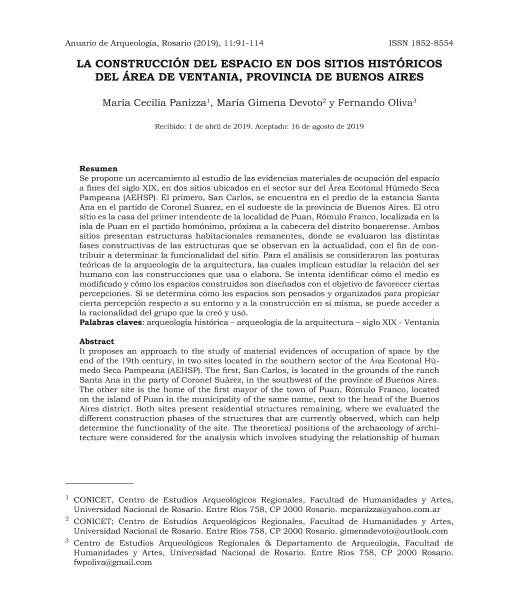Artículo
Se propone un acercamiento al estudio de las evidencias materiales de ocupación del espacio a finesdel siglo XIX, en dos sitios ubicados en el sector sur del Área Ecotonal Húmedo Seca Pampeana (AEHSP). El primero, San Carlos, se encuentra en el predio de la estancia Santa Ana en el partido de Coronel Suarez, en el sudoeste de la provincia de Buenos Aires. El otro sitio es la casa del primer intendente de la localidad de Puan, Rómulo Franco, localizada en la isla de Puan en el partido homónimo, próxima a la cabecera del distrito bonaerense. Ambos sitios presentan estructuras habitacionales remanentes, donde se evaluaron las distintas fases constructivas de las estructuras que se observan en la actualidad, con el finde con-tribuir a determinar la funcionalidad del sitio. Para el análisis se consideraron las posturas teóricas de la arqueología de la arquitectura, las cuales implican estudiar la relación del ser humano con las construcciones que usa o elabora. Se intenta identificar cómo el medio es modificado y cómo los espacios construidos son diseñados con el objetivo de favorecer ciertas percepciones. Si se determina cómo los espacios son pensados y organizados para propiciar cierta percepción respecto a su entorno y a la construcción en sí misma, se puede acceder a la racionalidad del grupo que la creó y usó. It proposes an approach to the study of material evidences of occupation of space by the end of the 19th century, in two sites located in the southern sector of the Área Ecotonal Húmedo Seca Pampeana (AEHSP). The first, San Carlos, is located in the grounds of the ranch Santa Ana in the party of Coronel Suárez, in the southwest of the province of Buenos Aires. The other site is the home of the first mayor of the town of Puan, Rómulo Franco, located on the island of Puan in the municipality of the same name, next to the head of the Buenos Aires district. Both sites present residential structures remaining, where we evaluated the different construction phases of the structures that are currently observed, which can help determine the functionality of the site. The theoretical positions of the archaeology of architecture were considered for the analysis which involves studying the relationship of human beings with constructions that uses or elaborates. Attempts to identify “how the medium is changed?” and “how the constructed spaces are designed with the aim of favouring certain perceptions?” If it is determined how the spaces are designed and organized to facilitate some perception with respect to its environment and the construction itself, you can access the rationality of the group who created it and used.
La construcción del espacio en dos sitios históricos del área de Ventania, provincia de Buenos Aires
Título:
The construction of space in two historical sites of the Ventania Area, Buenos Aires Province
Fecha de publicación:
12/2019
Editorial:
Universidad Nacional de Rosario. Facultad de Humanidades y Artes. Departamento de Arqueología
Revista:
Anuario de Arqueología
ISSN:
1852-8554
Idioma:
Español
Tipo de recurso:
Artículo publicado
Clasificación temática:
Resumen
Palabras clave:
ARQUEOLOGÍA HISTÓRICA
,
ARQUEOLOGÍA DE LA ARQUITECTURA
,
SIGLO XIX
,
VENTANIA
Archivos asociados
Licencia
Identificadores
Colecciones
Articulos(CCT - ROSARIO)
Articulos de CTRO.CIENTIFICO TECNOL.CONICET - ROSARIO
Articulos de CTRO.CIENTIFICO TECNOL.CONICET - ROSARIO
Citación
Panizza, María Cecilia; Devoto, María Gimena; Oliva, Fernando Walter Pablo; La construcción del espacio en dos sitios históricos del área de Ventania, provincia de Buenos Aires; Universidad Nacional de Rosario. Facultad de Humanidades y Artes. Departamento de Arqueología; Anuario de Arqueología; 11; 11; 12-2019; 91-114
Compartir




